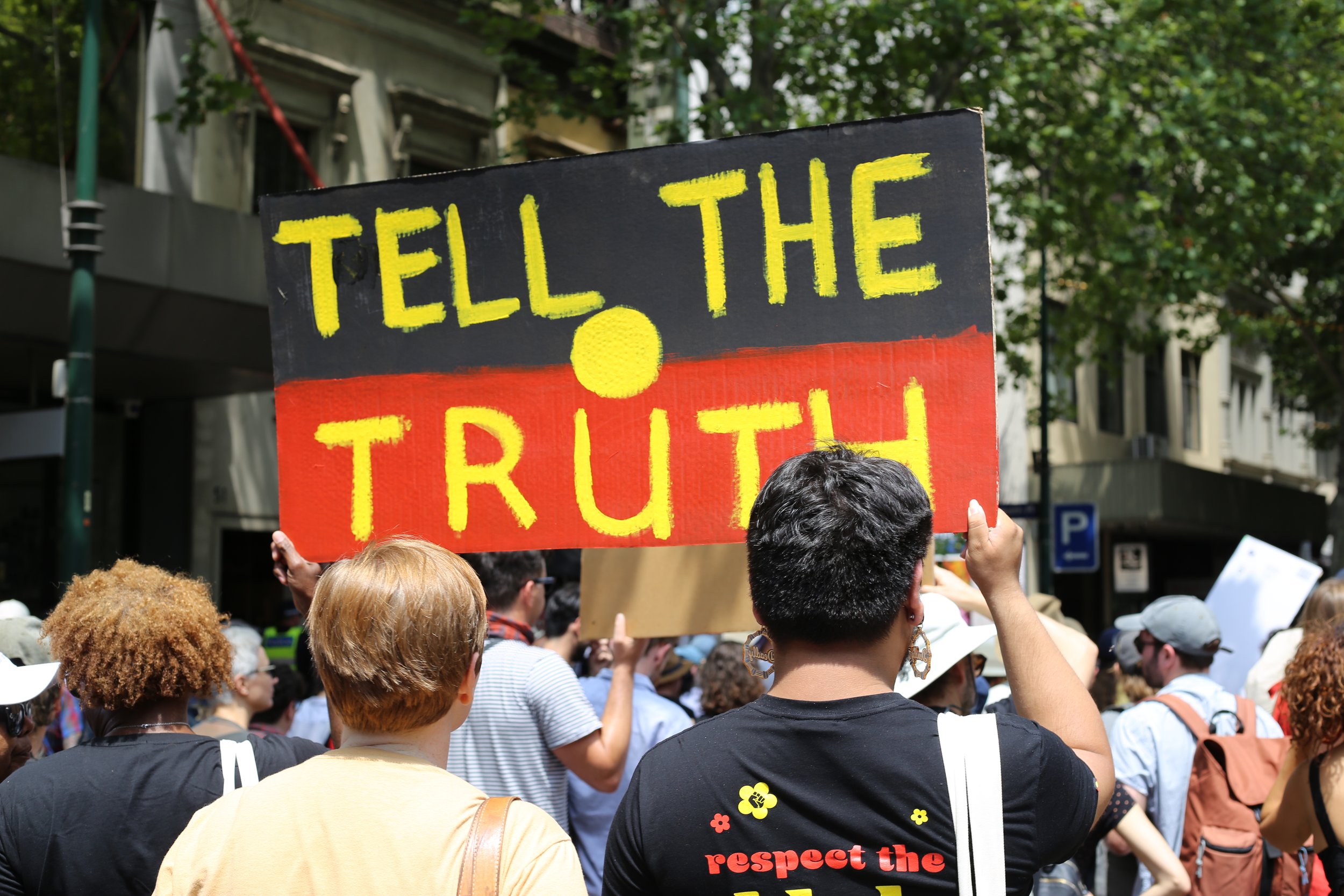
Advice for crafting winning messages
When we sing from the same song sheet,
and lead with stories of our strength and solutions,
we can win majority support for our demands.
In addition to the five messaging recommendations, here are some further considerations to take into account when crafting your message.
These tips work in the context of the referendum, and in building support for transformational change into the future.
Follow the Proven messaging structure
Shaping stories with this proven structure helps to ground messages in strength, draw attention to the institutions and people who cause us harm, share our expert solutions and paint the picture of how they help realise a better future for all of us.
-

Value
Start with a shared VALUE - these typically appeal to all audiences. Using a common sense statement that most people agree with is a strong way to open.
-

Villain
Then describe the VILLAIN who causes us harm - typically an institution or government policy. Be as specific as possible - who is involved, what are they doing, and what’s their motive?
-

Victory
Next, share your VICTORY, or a clear ask and solution. We know what’s best for our communities, so ground your victory in our strength, expertise and capability.
-

Vision
Close with a positive VISION, painting a picture of a better future for everyone. This provides hope to our base and persuadables who genuinely want things to be better for First Nations people, in a society that respects and values everyone.

Understand the central proposition
Good campaigns are built around a single proposition – an overarching message that is repeated over and over.
A single proposition must be easy to understand, emotionally compelling and morally strong, and works best when it rejects the opposition’s message.
‘Let’s listen’ is an example of a strong proposition.
Everyone can understand the simple idea that if you listen to the people most impacted before you make decisions, you’ll get better outcomes.
It is an obvious truism because it exists in many aspects of real life. You listen to your kids before buying their birthday present. The local council should listen to the community before deciding if they’ll build a library or a football field.
No one (except the opponents) can disagree with the statement: “we will make better laws and policies about First Nations people when we listen first”.
Here’s how the ‘Let’s listen’ proposition could guide your communications:
“Let’s listen to First Nations people”
“Yes, let’s listen”
“Yes: listen and respect”
“Do you think we should listen to First Nations people before policies are made that impact them?”

find your frame
A messaging frame is just like a picture frame, it helps our audience focus on what we want them to focus on, and excludes or blocks ideas outside it.
Below are five frames we recommend you embrace in messaging to win a resounding Yes and build widespread support for transformative change beyond it — each performed strongly in our research, particularly with persuadables.
To learn more about framing, click here to read our messaging 101.
Frame #1: Momentum
The frame that resonated most with our communities and the base, and also tested well with persuadables, is the idea that the vast majority of people writing Yes in the referendum will create momentum for broader transformative change beyond the referendum. Here’s a video that shows how the base (green), persuadables (yellow) and opposition (red) respond to the ‘momentum’ message.
Example message:
“In our democracy, the voting public has the final say and the Government must respect the will of the people.
First Nations people have been calling for change for decades but historically, governments only act if they feel pressure from voters.
With a resounding Yes vote in the referendum, we will have the momentum for big reforms and could see huge changes including treaties, land rights, truth-telling and justice.
Over the next decade, we can work together to leave future generations more united, where First Nations people are respected, listened to and treated with dignity.”
Frame #2: equity
One of the most promising findings is how strongly Australians believe in the value of equity – that people should have what they need to thrive, and nobody, regardless of income, race, gender, or geography, should be left behind. Persuadables believe that being locked out of decision-making is an inequity that should be fixed, making this a strong frame to embrace in our messaging.
Example message:
“Everyone should be treated fairly and equally respected. We should all have our say - especially in decisions that impact us.
But Aboriginal people are not treated fairly with decisions often being made top down without considering their ideas and perspective.
Voting Yes in the referendum can help to make our system fairer so that everyone has a chance to be heard.
This is an important step towards a society that respects First Nations people and culture and leads to meaningful improvements in the quality of life for Aboriginal people.”
Frame #3: First Nations led solutions
Persuadables strongly support First Nations-led solutions, they respect the knowledge and expertise of First Nations communities, and agree that policies are most effective if they’re shaped by the people they affect. The majority of persuadables agree that First Nations people have very specific knowledge and expertise (for example, fire and environmental management), and showed respect and support for our contribution to policy solutions.
Example message:
When we listen to each other, share our knowledge and work together, we all benefit.
Aboriginal people have a contribution to make on things like land and fire management and much more. But Governments have often refused to hear or take up this advice.
Writing Yes in the referendum is a way to say that we want to hear the wisdom of the oldest living culture on Earth. Everyone can benefit from an Aboriginal perspective.
When we include Aboriginal ideas in our democratic process we will all benefit.
Frame #4: who we could be as a nation
Messages that paint a picture of our aspiration to be a better nation, one that celebrates and respects Aboriginal people as the oldest continuing culture on earth, are proven to build support amongst persuadables.
This is particularly true when we bring in the comparison to Aotearoa/New Zealand. People can plainly see they are better at respecting, valuing and celebrating Māori culture and communities, than we are at respecting First Nations here, and it’s something people aspire to.
Example message:
“We want a country that values all people, if they have been here five years, five generations or five thousand generations.
But too often First Nations people have been ignored when we discuss who we are and what sort of country we want to be.
Writing Yes in the referendum is a way to show that we value Aboriginal people and culture and want to hear their perspectives.
Just as New Zealand has embraced Māori culture, we can create a future where we respect and value Aboriginal people and take pride in the oldest living culture in the world.”
Frame #5: Representation
Representation and constitutional recognition are two frames being used to talk about the referendum.
Our research shows representation is more meaningful than constitutional recognition, which many First Nations people reject as only symbolic change.
Using constitutional recognition also puts the author of the story as Australia, rather than our communities, and in doing so, makes invisible our aspirations like truth-telling, treaties, equity and land rights.

How to do truth-telling
Truth-telling is a critical element that underpins all of our campaigns and must be done right.
We need to use honesty and stories of healing to pair together the full impact of the truth, with the ‘action’ or better future we want to create.
Embrace
Here’s an example of how to pair truth-telling with action to create a better future:
“We must be honest about Australia's ugly history regarding Aboriginal people including massacres, stolen land, stolen children and violent repression of language and culture so we can work together and build a better and fairer future for everyone.”
If we have limited space to go into detail (such as a social media post), it works well to allude to hard truths using language like:
“We need to have a true and honest conversation about our past, so we can build a better future together”.
Replace
Long lists of negative statistics.
Descriptions of our brutal history and present policies without an action or ask.
Why?
Pairing truth with action helps non-First Nations people move past guilt to action. It’s also consistent with the First Nations strengths frame. If we only talk about the violence and dispossession that has been done to First Nations people, it’s too easy for audiences to infer deficit instead of the strength we want them to take away from our messages.

Understanding First nations audiences
In our research, we found many First Nations people are undecided about how they’ll vote, and want to have conversations in their communities and with other First Nations people.
Questions about the representative nature of the Voice to Parliament and the the advisory nature of it, as well as mistrust of government were the three main concerns we found. To find out more, along with tailored messaging advice to respond to each concern, you can download the full report from our resources page here.






